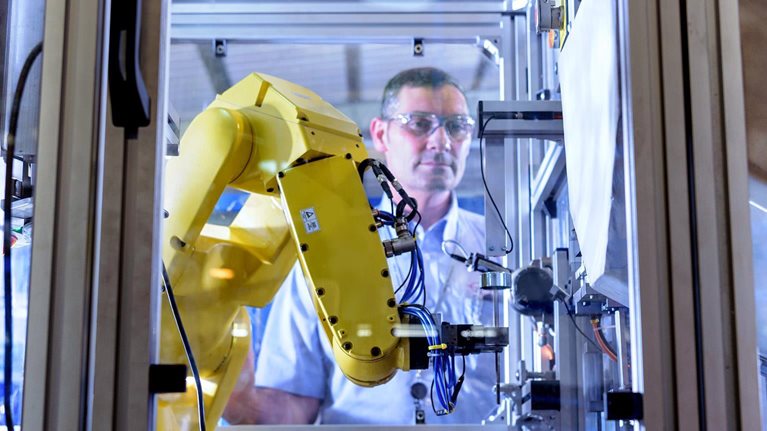We are on the cusp of a new age of automation. Robots have long been familiar on the factory floor, and software routinely outperforms humans when used by delivery companies to optimize routes or by banks to process transactions. But rapid strides being made in artificial intelligence (AI) and robotics mean machines are now encroaching on activities previously assumed to require human judgment and experience.
Stay current on your favorite topics
For instance, researchers at Oxford University, collaborating with Google’s DeepMind division, created a deep-learning system that can read lips more accurately than human lip readers—by training it, using BBC closed-captioned news video. Similarly, robot “skin” is able to “feel” textures and find objects by touch, and robots are becoming more adept at physical tasks (such as tying a shoelace) that require fine motor skills. There are still limitations. Machines lack common sense, can’t always pick up on social and emotional cues, and still struggle to understand and generate natural language. Yet the pace of technological progress, propelled by massive increases in computing power and cloud storage, suggests the next frontier will soon be crossed.
Senior executives have two critical priorities in this world. First is to gain an appreciation for what automation can do in the workplace. While cost reduction, mainly through the elimination of labor, attracts most of the headlines and generates considerable angst, our research shows that automation can deliver significant value that is unassociated with labor substitution. In this article, we describe a wide range of business opportunities that automation is creating: for example, helping companies get closer to customers, improve their industrial operations, optimize knowledge work, better understand Mother Nature, and increase the scale and speed of discovery in areas such as R&D.
As leaders consider this wide range of possibilities, they have a second priority, which is to develop an action plan. That plan should include a view of both tactical and strategic opportunities for their companies, a blueprint for building an organization in which people work much more closely with machines, and a commitment to helping shape the important, ongoing debate about automation and the future of work.
What automation can do
To gauge the business-performance benefits that automation could deliver beyond labor-cost savings, we asked experts to consider how it could transform working practices in a range of settings—a hospital emergency department, aircraft maintenance, an oil and gas operation, a grocery store, and a mortgage brokerage. The results, though hypothetical, are striking. Measured as a percentage of operating costs, the changes deliver benefits ranging from 15 percent in a hospital emergency department, to 25 percent for aircraft maintenance, and over 90 percent for mortgage origination.
While labor substitution accounts for some of this value, additional performance benefits are considerable in all cases, and sometimes greater than the value of labor-cost reductions. In oil and gas operations, for example, performance gains in the form of higher throughput, higher productivity, and higher safety—all unrelated to labor substitution—account for fully 85 percent of the potential value unlocked by automation. And that’s just one example. Automation is enabling companies to make the following far-reaching set of moves:
- Get closer to customers. Affectiva, a Boston-based company, uses advanced facial analysis to monitor emotional responses to advertisements and other digital-media content, via a webcam. Citibank works with Persado, a start-up that uses AI to suggest the best language for triggering a response from email campaigns. The results are a purported 70 percent increase in open rates and a 114 percent increase in click-through rates. And Kraft used an AI-enabled big data platform to reinvent its Philadelphia Cream Cheese brand by better understanding the preferences of different consumer segments.
- Improve industrial operations. GE uses machine-learning predictive-maintenance tools to halve the cost of operations and maintenance in certain mining activities and so extend the life of its existing capital. Rio Tinto has deployed automated haul trucks and drilling machines at its mines in Pilbara, Australia, where it says it has seen a 10 to 20 percent increase in utilization in addition to lower energy consumption and better employee safety.
- Optimize knowledge work. It’s becoming more common for a software robot to receive a user ID, just like a person, and then to perform rules-based tasks such as accessing email, performing calculations, creating documents and reports, and checking files. Besides scalability and higher throughput and accuracy, the results include built-in documentation of transactions for audit, compliance, and root-cause analyses. Meanwhile, numerous financial institutions and other companies deploy robotic process automation to collect and process data.
- Harness the power of nature. Land O’Lakes’ WinField United compiles data on US crops to help farmers make key decisions throughout the year, including which seeds to purchase, soil and nutrient requirements, and yield potential. Meanwhile, the Coca-Cola Company’s Black Book model uses algorithms to predict weather patterns and expected crop yields to inform procurement plans for their Simply Orange juice brand, so that no matter what the quality and quantity of the crops, they can be blended to replicate the desired taste. The model also enables the company to overhaul its plans within minutes if weather conditions threaten to damage crops.
- Increase scale and speed. The potential for AI-enabled automation to create scale, boost throughput, and eliminate errors creates a range of opportunities for discovery in R&D. For example, GlaxoSmithKline’s machine-learning-enabled model-selection process helps the company analyze many times more models in a matter of weeks as it could in several months using traditional processes. In the automotive industry, Nissan has cut in half the time it takes to move from final product design to production, thanks to digital and automation. And BMW has reduced machine downtime significantly in some of its plants through AI-enabled condition-based maintenance, effectively generating fresh economies of scale with minimal investment.
Would you like to learn more about the McKinsey Global Institute?
An automation agenda for the CEO
This dizzying array of possibilities makes it critical for today’s CEO to develop an automation action plan. A good one will include the three following components.
A tactical and strategic view of the opportunities
As leaders seek to plan and prioritize what they might achieve with automation, they must grapple with two imperatives. First is to examine their current business systems to identify which components will benefit not just from labor savings but from improvements in speed, quality, flexibility, and service. Developing a comprehensive heat map that examines each activity in every business line to identify where automation potential is high is a helpful first step. Activities involving data collection or processing, as well as physical activities in predictable environments, are likely to be the first automation candidates.
However, extracting value from automation often entails redesigning entire processes, not just automating individual components of the process. Take mortgage origination. We estimate automation could cut the current process time in the United States from an average 37 days to less than 1, which not only cuts costs but eliminates errors, reduces defaults, raises customer satisfaction, and lowers drop-out rates. But accomplishing this would mean a transformation of the approval process. As machines take over a great majority of the routine work, mortgage advisors would devote more of their time to client support and handling exceptions. Risk underwriters too would only handle exception cases and focus instead on improving the overall risk framework, controls, and models, while data scientists would work on improving risk models.
The second imperative is for leaders to look beyond their current business processes and start imagining how automation will enable them, and others, to make bolder moves. The question to ask: How could a disruptive competitor or a player along the value chain use automation to upend your business model? In sectors as varied as transportation, hospitality, and retail, data assets and analytics capabilities have helped companies circumvent traditional barriers to entry (such as physical capital investments) and erect new ones (digital platforms with powerful network effects), rapidly building scale in the process. Add automation to the mix and the opportunity—or threat—becomes greater still. Uber, for example, which expanded rapidly without owning a car fleet, uses automation to boost the power of human management, with just one manger coordinating 1,000 drivers compared with a typical limousine company that has about one manager for every 20 to 30 drivers. And Google’s DeepMind is blurring traditional sector boundaries. Having analyzed energy usage in Google’s data centers and cut consumption by 40 percent, DeepMind went on to enter discussions with a grid operator in the United Kingdom to help them balance electricity supply and demand. No wonder that the titan who takes on your company in the future may come out of left field (see “Competing in a world of sectors without borders”).
A plan for integrating automation into the workplace
Almost every occupation has partial automation potential, though few can as yet be entirely automated. Take the job of a salesperson in a clothing store. Machines can manage store inventory well by detecting patterns in sales. But no robot can listen to a customer’s story about a looming, stressful family event, recommend an outfit for it, and give the customer an empathetic thumbs up after he or she emerges from the dressing room.
Future automation advances will depend upon more than technical progress. The cost of development and deployment relative to the benefits, regulation, and social acceptance are just some of the factors that will dictate the pace of change. Our research suggests it may take more than three decades for just half of all work activities (not entire jobs) to be automated. The takeaway is that the workplace norm for years to come will be people working alongside machines, with profound implications for the way the workforce is structured and organized.
Companies will of course have to recruit automation-savvy talent, from experts in sensory or pattern-recognition technologies or natural language processing, to data scientists able to interpret and integrate massive amounts of information, to roboticists who can build, train, and repair intelligent machines. Simultaneously, however, many workers will need retraining to acquire new skills, focusing on those activities that machines have yet to master, and learning to work more closely with machines. Until recently, powerful manufacturing robots that can lift or weld have been kept well away from humans, often in cages, because of the risk of accidents. But today’s robots can work intelligently and safely alongside humans. At BMW, for example, people continue to play a critical role in car-door assembly, but robots assist in close proximity with the fitting of door seals, which require precision, force, and constant contact pressure.
Frequent redeployment, with people shifting to new roles and tasks, will also be a feature of the workplace as automation gathers pace and processes are transformed. Companies will require a strategy—and considerable management talent—to navigate this transition to the new age of automation.
A commitment to participating in a broader dialog on the future of work
The benefits of automation enjoyed by individual firms will feed into the global economy. We estimate automation could raise productivity growth by between 0.8 and 1.4 percent annually, giving a welcome boost to economic growth at a time when demographic trends threaten to dampen it. There are broader societal benefits too, as automation can help tackle some of our most pressing challenges such as climate change and disease. Researchers at McMaster University and Vanderbilt University, for example, have used computers to exceed the human standard in predicting the most effective treatment for major depressive disorders and eventual outcomes of breast-cancer patients.

Four fundamentals of workplace automation
Yet for all the positive effects, many questions about the impact of automation on society remain unanswered, particularly regarding employment and incomes. In the past, technological progress has not resulted in long-term mass unemployment, because it also has created additional, and new, types of work. Between 1900 and 1970, the percentage of people employed in agriculture in the United States dropped from around 40 percent to less than 2 percent, but labor was redeployed into other sectors, including manufacturing. During this time, incomes for most of the population increased along with productivity. More recently, one-third of new jobs created in the United States in the past 25 years were types that did not previously exist, or barely existed.
We cannot know for sure whether these historical precedents will be repeated. But we do know that business leaders will be at the forefront of what is afoot as they move to embrace automation. They will be drafting the blueprints of the automated workplace, the first to understand which new skill sets will be needed, which old workplace orthodoxies will be obsolete, and how machines and humans will work together. It falls to them, therefore, to take what they have learned beyond their corporate walls and engage in a broader dialogue to help shape the future.
That may mean pressing home to policy makers the urgency of investing more, not less, in human capital at the very time that machines are taking on more activities. It may mean working alongside educators to pinpoint skill gaps and help establish priorities, as well as funding mechanisms, for lifelong-learning programs that address the needs of workers changing employers more frequently. It may even mean helping to assess the need for new mechanisms that support transitions between employers, and help workers whose wage levels are threatened by automation. The point is, executives’ vantage point gives them an important voice in the future-of-work debate that needs to be heard if the value of automation is to be captured at the same time as its challenges are addressed.


